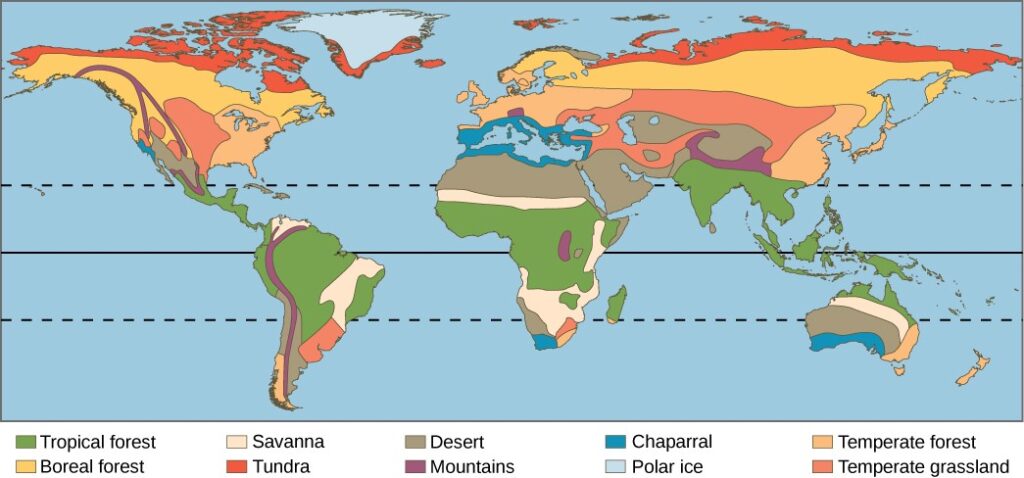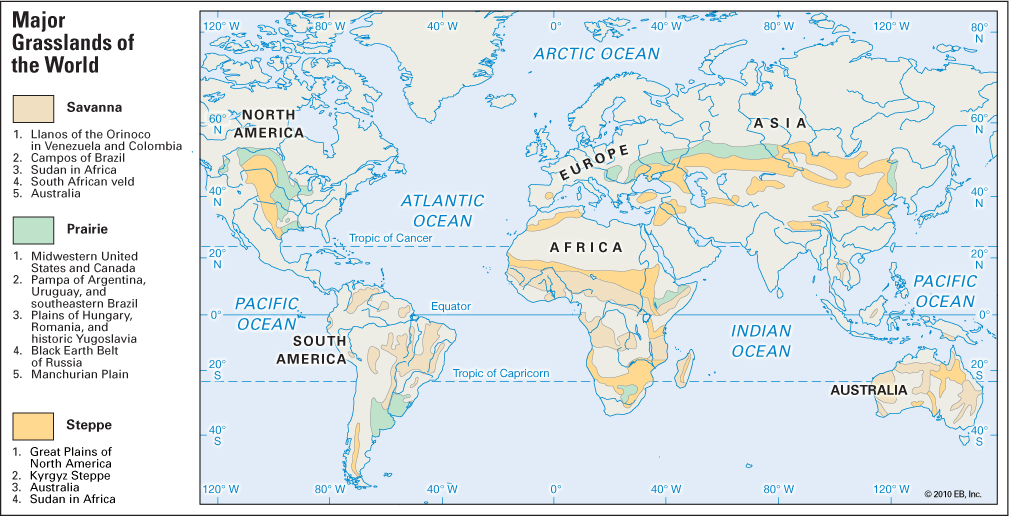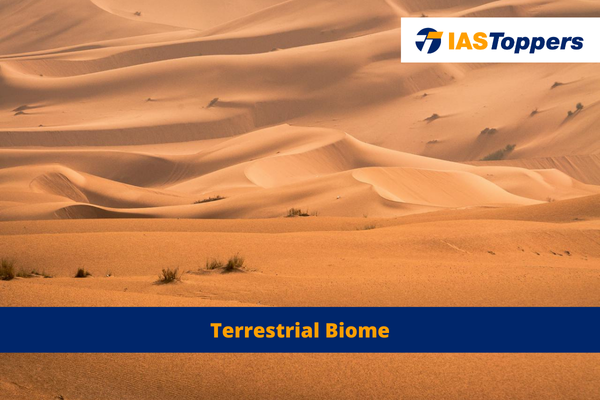Terrestrial biomes are large ecosystems categorized by unique climate and vegetation characteristics. They cover the earth’s landmass and are crucial for biodiversity as they house a variety of flora and fauna adapted to specific environments. The major types of terrestrial biomes include Forests Grasslands, Deserts, and Tundra. Each of these biomes has unique climatic conditions and supports particular types of plant and animal life. In this article, you will learn about what is Biome, factors affecting Biomes and various types of terrestrial biomes. It is important topic for GS Paper-3 Environment & Ecology of UPSC IAS Exam. To explore other interesting Environment & Ecology concepts similar to Terrestrial Biomes, check out other articles of IASToppers.
Table of Content
- What is Biome?
- Factors Affecting Biomes
- Classification of Biomes
- Terrestrial Biomes
- Forests
- Tropical Rain (Evergreen) Forest
- Tropical Deciduous Forests
- Temperate Deciduous Forests
- Temperate Evergreen Forests
- Coniferous forests
- Mediterranean
- Grasslands
- Deserts
- Tundra
- Forests
- Conclusion
- FAQs on Terrestrial Biomes
What is Biome?
- Biome may be defined as a large natural eco-system wherein the total assemblage of plant and animal communities is studied.
- Here, all the biota has the minimum common characteristics and all the areas of biomes are characterized by more or less uniform environmental conditions.

Factors Affecting Biomes
- Length of day light and darkness. This is mainly responsible for duration of photosynthesis.
- Mean temperature as well as difference in temperature.
- Length of growing season.
- Precipitation which includes total amount, variations over time and intensity.
- Wind flow that includes speed, direction, duration and frequency.
- Soil types
- Slope
- Drainage
- Other plant and animal species
Classification of Biomes
There are two major bases of classifying biome.
1. On the basis of climate with special emphasis on availability of moisture
According to this basis, biomes are determined by the degree to which moisture is available to plants in a scale hanging from abundant (forest biome) to almost scarce (desert biome).
According to this classification, there are 4 major terrestrial biomes:
- Forests terrestrial biome
- Grasslands terrestrial biome
- Deserts terrestrial biome
- Tundra/ Savanna terrestrial biome
2. On the basis of climate and vegetation
Below is the summary chart of terrestrial biomes based on the climate and vegetation.
| Biomes of the first order (Based on climatic zones) | Biomes of the first order (Based on climatic zones) | Biomes of the first order (Based on climatic zones) |
| Tropical Biome | Tropical Forest Biome | Evergreen Rain-Forest Biome |
| Semi-evergreen Forest Biome | ||
| Deciduous Forest Biome | ||
| Semi-deciduous Forest Biome | ||
| Monanne Forest Biome | ||
| Swamp Forest Biome | ||
| Savanna Biome | Savanna Forest Biome | |
| Savanna Grassland Biome | ||
| Desert Biome | Dry and arid desert Biome | |
| Semi-arid Biome | ||
| Temperate Biome | Boreal Forest Biome (Taiga Forest Biome) | North American Biome |
| Asiatic Biome | ||
| Mountain Forest Biome | ||
| Temperate Deciduous Forest Biome | North American Biome | |
| European Biome | ||
| Temperate Grassland Biome | Soviet Steppe Biome | |
| North-American Prairies Biome | ||
| Pampa Biome | ||
| The Mediterranean Biome | Australian Grassland Biome | |
| Southern Hemisphere Biome | ||
| Temperate Rainforest Biome | ||
| Tundra Biome | Arctic Tundra Biome | |
| Alpine Tundra Biome |
Terrestrial Biomes
Below are the different types of earth’s terrestrial biomes.
A. Forests
Forests are of many different types, depending on the climatic regime in which they are found.
- Tropical rain forests
- Tropical Deciduous Forests
- Temperate deciduous forests
- Temperate Evergreen Forests
- Boreal or north coniferous forests
- Mediterranean Vegetation
1. Tropical Rain (Evergreen) Forest
- These are in the tropical region of very high rain fall.
- Such forests are well developed over the western coast of India and North eastern Himalayas and scattered in south east Asia, west Africa and north coast of South America.
- The tropical evergreen forests are found between 5° and 10° north and south of the equator. Its greatest range is located in the Amazon Basin (South America), Congo Basin (Africa), and Indo-Malaysian region (Java, Sumatra, Borneo, Malaysia, and Guinea).
Main characteristics
- Temperature and light intensity are very high.
- Rain fall is greater than 200 cm. per year, with average temperature of 20-250C.
- The trees reach a height up to 60 meters or even more.
- Soil of these regions is rich in humus.
- The rate of turnover of the nutrients is very high leading to high productivity and have highest standing crop and biomass.
Flora
- The vegetation includes broad evergreen trees of 200 feet like Health bamboos, ferns, shrub etc. Epiphytes and woody wines (liannas) are also abundant.
- Many tree species show buttresses (swollen stem bases) and leaves with drip tips.
Fauna
- These forests have rich invertebrate and vertebrate fauna. Snails, centipedes, millipedes and many insect species are common near the forest floor.
- Rhacophorus (flying frog), aquatic reptiles, Chameleon and many birds are common in these forests.
- Mammals of these forests are sloths, monkeys, ant eaters, leopards, jungle cats and giant flying squirrels.
2. Tropical Deciduous Forests
- Tropical deciduous are the monsoon forests found in the large part of India, northern Australia and in central America.
- These regions experience seasonal changes.
- Trees shed their leaves in the dry season to conserve water.
- The hardwood trees found in these forests are sal, teak, neem and shisham.
- Tigers, lions, elephants, langoors and monkeys are the common animals of these regions.
3. Temperate Deciduous Forests
- Trees of deciduous forests shed their leaves in autumn and a new foliage grows in spring.
- They occur mostly in northwest, central and eastern Europe, eastern north America, north China, Korea, Japan, far eastern Russia and Australia.
Climate:
These forests occur in the areas of moderate climatic conditions such as:
- Annual rainfall is 75 to 150 cm
- Winter lasts for four to six months.
- Temperature ranges between 10 to 20°C.
- Soil is brown and rich in nutrients.
Flora:
- Commonly found trees in this ecosystem are oak, birch heath, chest nuts, pitch pine, cyprus.
Fauna:
- Invertebrate fauna comprises green oak moth, bark beetle, green flies, aphids, sapflies, moths and butterflies.
- Prominent grazers are grass eating rodents, deer and bison.
- Rodents play a very important role in these forests.
- They feed on the seeds, fruits and leaves of the trees and consume much more food than the large sized grazers.
- Common carnivores include wild cat, wolves, foxes, tawny owl and sparrow hawk. Black bear, raccoons and skunks are the omnivorous animals of these forests.
4. Temperate Evergreen Forests
- The temperate evergreen forests are located in the mid-latitudinal coastal region.
- They are commonly found along the eastern margin of the continents, e.g., In south east USA, South China and in South East Brazil.
- They comprise both hard and soft wood trees like oak, pine, eucalyptus, etc.
5. Coniferous forests
- Coniferous forests are also known as Taiga or Boreal forests.
- They extend as a continuous belt across north America and north Eurasia below the arctic tundra.
- In the Himalayas, these are distributed above 1700 to 3000 metre altitude.
- They also occur at high altitude below the alpine tundra and tree line.
- The soils found in boreal forests are typically thin podzols and tend to be nutrient-poor due to several factors:
- Cold climates slow down the process of rock weathering, leading to reduced nutrient release.
- Decomposition of conifer needles takes a long time and yields few nutrients, resulting in a low humus content.
Climate:
- Cold climate with long and harsh winters for more than six months.
- Mean annual temperature is below 0°C.
- Soil is poor in nutrients and acidic in nature.
Flora:
- Coniferous forests are characterized by conifers (gymnosperms).
- They are evergreen, drought resistant and woody.
- In many species the canopy is cone shaped.
- The common species of trees of these forests are Spruce, fir and pine trees.
- The productivity is much less than other ecosystem.
Fauna:
- There are very few animals in these forests.
- The herbivores include red squirrel, deer, goat, mule, moose etc. while carnivores include timber wolves, lynxes, wolverine, weasels mink and bear.
6. Mediterranean
- The west and south west margins of the continents have Mediterranean vegetation.
- It is mostly found in the areas around the Mediterranean Sea in Europe, Africa and Asia, hence the name.
- This kind of vegetation is also found outside the actual Mediterranean region in California in the USA, south west Africa, south western South America and South west Australia. These regions are marked for hot dry summers and mild rainy winters.
- Citrus fruits such as oranges, figs, olives and grapes are commonly cultivated here because people have removed the natural vegetation in order to cultivate what they want to.
- There isn’t much wildlife here.
B. Grasslands
- Grasslands are dominated by the grasses.
- They occupy about 20% of the land on earth’s surface.
- They occur in both tropical and temperate regions where environmental conditions are better than that of the desert but rainfall is not enough to support the growth of trees.
- They consist of monocotyledons (plants with narrow leaves growing from the base) and are comparatively resistant to intensive grazing.
- Grasslands represent an ecotone (a zone in between two ecosystems) and are found between forest on one side and deserts on the other.
- They are subjected to greater variation of temperature, moisture, wind and light intensity of the sun.

Various names of Grasslands
Grasslands are known by various names in different parts of the world.
| Grasslands | Region |
| Steppe | Europe and North Asia |
| Pustaz | Hungary |
| Prairies | USA |
| Pampas | Argentina |
| Veld | South Africa |
| Downs | Australia |
| Canterbury | New Zealand |
| Savannah | Africa and Australia |
| Taiga | Europe and Asia |
There are mainly two types of grasslands:
Tropical and subtropical Grasslands:
- They occur on either side of the equator and extend till the tropics.
- This vegetation grows in the areas of moderate to low amount of rainfall.
- The grass can grow very tall, about 3 to 4 metres in height.
- Savannah grasslands of Africa are of this type.
- Elephants, zebras, giraffes, deer, leopards are common in tropical grasslands.
Temperate Grasslands:
- These are found in the mid-latitudinal zones and in the interior part of the continents.
- Usually, grass here is short and nutritious.
- Wild buffaloes, bisons, antilopes are common in the temperate region.
Flora and fauna:
- Grasses are the dominating plants with scattered drought resistant trees in the tropical grasslands. Trees are less than 10 m in height.
- Animals are much reduced in grasslands because there is no shelter.
- The large herbivores of this biome are bison, proghorn (North America) wild horse, ass, saiga (Eurasia), zebra and antelope (South Africa).
- Carnivores are quite small in number and size They are coyotes, weasels, badgers foxes and ferrets.
- Hawks, lark sparrows, warblers, Great Indian Bustard and peafowl are the common birds found in grassland. Grasslands are very rich in reptilian and insect fauna.
C. Deserts
- Deserts are waterless barren regions of the earth.
- They occupy about 1/7th of the land on earth’s surface.
- Deserts form an extreme condition in sequence of ecosystems with respect to the climatic condition.
- They occur in two belts that encircle the northern and southern hemispheres roughly centered over the tropics of Cancer and Capricorn.
- The Sahara is the world’s largest warm-weather desert.
- Desert in Rajasthan is the most highly populated hot desert in the world.
Climate:
- Annual rain fall is very little. It may be less than 25 cm per annum. At some places if it is high, it is unevenly distributed.
- Temperature may be very high in subtropical deserts and very low in cold deserts e.g., Ladakh.
- Winds have high velocity
Flora and fauna:
- Cacti, Acacia, Euphorbia and prickly pears are some of the health common desert plants. Desert animals are insects, reptiles, and burrowing rodents.
- Desert shrew, fox, kangaroo, wood rat, rabbit, armadillo are common mammals in desert. Camel is known as the ship of the desert as it can travel long distances without drinking water for several days.
D. Tundra
- The word tundra means a “barren land” since they are found in those regions of the world where environmental conditions are very severe.
- There are two types of tundra: Arctic and Alpine.
Distribution
- Arctic tundra extends as a continuous belt below the polar ice cap and above the tree line on the northern hemisphere.
- It occupies the northern fringe of Canada Alaska, European Russia, Siberia and island group of arctic oceans.
- Since mountains are found at all latitudes therefore alpine tundra show day and night temperature variations.
Climate
- A permanently frozen subsoil called permafrost is found in the Arctic and Antarctic tundra.
- The summer temperature may be around 15°C and in winter it may be as low as –57°C in arctic tundra.
- A very low precipitation of less than 400 mm per year.
- A short vegetation period of generally less than 50 days between spring and autumn frost
- Productivity is low
Flora
- Typical vegetation of arctic tundra is cotton grass, sedges, dwarf heath, willows birches, and lichens.
- On bare rocks, simple plant life such as mosses and lichens can be found in limited quantities.
Fauna
- Animals of tundra are hurepian reindeer, musk ox, arctic hare, caribous, lemmings and squirrel.
- Their body is covered with fur for insulation and insects have short life cycles which are completed during favourable period of the year.
- Amphibians and reptiles are virtually non-existent in these areas.
- Many animals in these regions have long lifespans, such as the arctic willow, which can live for 150 to 300 years.
Conclusion
The distribution of terrestrial biomes across the world has an important role in keeping Earth’s ecological harmony. There is need to save terrestrial biomes of the world, each special in its own way, to avoid losing habitats and the species living in them. The answer lies in stopping harmful actions like deforestation and land misuse, while encouraging new forests to grow and repairing damaged habitats.
What is a Terrestrial Biome?
A terrestrial biome is a large, natural ecosystem on land where plant and animal communities share common characteristics based on their environment.
What is the largest terrestrial biome on earth?
The largest terrestrial biome on earth is the Taiga or Boreal Forest, mainly spanning across North America and Eurasia
What are the major terrestrial biomes of the world?
The major terrestrial biomes of the world include Forests, Grasslands, Deserts, and Tundra, each having unique climate and vegetation characteristics.
What are the examples of terrestrial biomes?
Examples of terrestrial biomes include Tropical Rainforests, Temperate Deciduous Forests, Savannas, Prairies, Deserts, and the Arctic Tundra.
Which terrestrial biome has the most biodiversity?
The terrestrial biome with the most biodiversity is the Tropical Rainforest, due to its high rainfall and warm temperatures year-round.
What are the major terrestrial and aquatic biomes?
The major terrestrial biomes include Forests, Grasslands, Deserts, and Tundra. Major aquatic biomes include Freshwater (lakes, rivers, and wetlands) and Marine (oceans, coral reefs, and estuaries).


